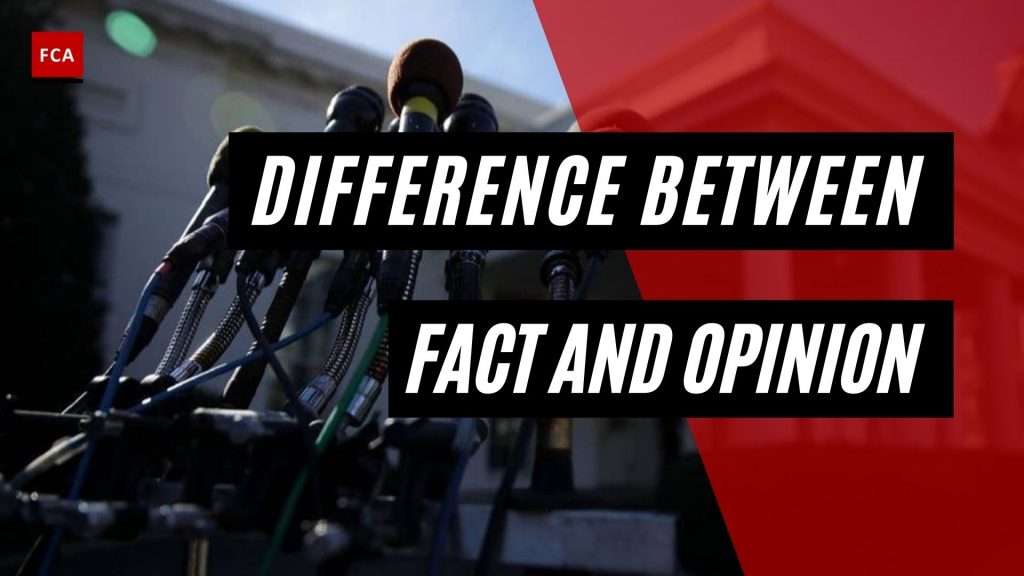In the age of information overload, the ability to discern between facts and opinions has become more critical than ever. With numerous sources of information available at our fingertips, it’s essential to be able to evaluate and interpret the information we consume accurately.
The ability to distinguish the difference between fact and opinion not only helps us make informed decisions but also fosters healthy debates and conversations.
This blog post delves into understanding the key differences between facts and opinions, recognizing their significance in various contexts such as news media, literature, and social media, and exploring effective strategies for distinguishing between them.
By the end, you will be equipped with the knowledge to navigate the vast sea of information and draw accurate conclusions based on the veracity of the data presented to you, keeping in mind the difference between fact and opinion.
Key Takeaways
Understanding the difference between fact and opinion is essential for making informed decisions.
Strategies such as language analysis, evidence seeking, and subjectivity recognition can help us differentiate facts from opinions in various contexts.
Examples of a fact include objectively verifiable truths while an opinion is based on personal beliefs that cannot be universally accepted as true.
Defining Facts and Opinions

Grasping the difference between facts and opinions paves the way for effective evaluation and interpretation of information. While facts are objective and verifiable, opinions are subjective and depend on individual beliefs and experiences.
A deeper exploration of facts and opinions will enhance our understanding of their differences.
A fact is a precise detail that is accurate based on verifiable evidence, a first-hand account, or the result of an accepted scientific procedure.
Examples of facts include “The Earth revolves around the Sun” and “Water freezes at 0 degrees Celsius”. For a statement to be classified as a fact, it must be substantiated through verification and be supported by evidence, figures, records, etc. Facts represent objective reality, whereas opinions are subjective interpretations.
It is worth noting that facts are universally accepted truths, and their accuracy does not depend on an individual’s belief or opinion. Next, we will delve into the nature of opinions and their distinction from facts.
Opinions are not facts, instead, they are interpretations or value judgments. They cannot be proven or verified. Opinions are expressions of an individual’s sentiments, convictions, or perspectives, and they may vary from person to person.
For instance, “I believe the new movie is unsatisfactory” is an opinion. Opinions are influenced by personal experiences, values, and beliefs, making them subjective in nature.
Since facts are evidence-backed and opinions aren’t subject to validation, conscious awareness of this distinction can improve our evaluation of information. Our next section will explore this further.
Identifying Facts and Opinions in Various Contexts

In the vast sea of statistics, distinguishing between facts and opinions requires keen discernment. Different platforms present exclusive challenges. For instance, news media interweaves factual reports with editorial commentaries, making it indispensable to separate event descriptions from commentary. Academic papers, grounded in research, often mingle raw data with subjective understandings, demanding a clear understanding of where one ends and the other begins. Commercials, personal narratives, and social media blur lines even further, mixing product details with convincing pitches or factual events with personal emotions and viewpoints.
Literature and art, primarily vehicles for subjective expression, occasionally embed factual contexts within fictional or artistic depictions. The equilibrium between the creator’s vision and real-world references can be intricate. Meanwhile, everyday conversations and debates blend personal involvements with universally acknowledged truths, necessitating active listening and analytical skills to differentiate.
Navigating these diverse circumstances requires a strategic approach. Being aware of the source, intent, and nature of content is crucial. Regularly questioning and cross-referencing evidence helps ensure accurate conception and fosters informed announcements.
Accurate interpretation and analysis rely on our ability to correctly classify facts and opinions across a variety of contexts, including news media, literature, and social media.
We will further investigate the role of facts and opinions within these contexts and discuss the challenges in differentiating them in the subsections to follow.
News Media, Literature, and Social Media
In news media, facts are objective information that can be verified to be true or false. They address the questions of who, what, where, when, why, and how.
On the other hand, opinions are expressions or beliefs that may or may not be supported by evidence and often advocate a single viewpoint.
Differentiating facts from opinions in news media is vital to uphold credibility and foster objectivity, which enables readers to form their own viewpoints.
Examples of facts present in news stories, which are a part of news media fare, may include details such as the date of an event, the number of people affected by an event, or the location of an event. Opinions present in news media may include statements such as “the president’s policies are bad for the economy” or “the new law is a step in the right direction”.
The intermingling of facts and opinions in literature necessitates their distinction for a more complete understanding of the text. Analyzing language can assist in distinguishing between facts and opinions when reading literature by examining words that denote opinion, such as “I think” or “I believe”.
Additionally, seeking supporting evidence can help differentiate between facts and opinions by examining evidence that corroborates the assertions presented in the text.
Recognizing subjectivity can also assist in distinguishing between facts and opinions when reading literature. Words that suggest bias or opinion, such as “I feel” or “I believe,” can serve as indicators of subjectivity.
In the next subsection, we will explore the challenges of differentiating between facts and opinions on social media platforms.
Social media platforms are rife with an amalgamation of facts and opinions. Distinguishing between the two can be challenging, as objective reporting and personal views often overlap in this environment. The fast-paced nature of social media further complicates the process of discerning facts from opinions, as users often share and consume information without taking the time to verify its accuracy.
Navigating social media and making informed decisions requires the application of strategies discussed above, including language analysis, evidence seeking, and subjectivity recognition. By doing so, we can differentiate between facts and opinions, avoid misinformation, and engage in productive discussions.
Strategies for Distinguishing Facts from Opinions

Having explored the importance of identifying facts and opinions across various contexts, we will now examine strategies to effectively distinguish between the two. These strategies include:
Analyzing language
Seeking supporting evidence
Recognizing subjectivity
Language analysis plays a key role in distinguishing facts from opinions. Using objective language, verifiability, subjectivity, and markers like ‘I believe’ or ‘in my opinion’ can aid in this differentiation.
By being mindful of the language used in a statement, we can identify biased words and phrases that may indicate an opinion. Recognizing words that suggest personal opinion, such as “I think” or “I believe,” can help us determine if a statement is a fact, an opinion, or an inconclusive statement.
Crossing the vast landscape of information entails the ability to distinguish between facts and opinions. To do this efficiently, one must adopt a multi-faceted method. Begin by inspecting the verifiability of the statement; facts can be validated with evidence, while opinions are based on personal principles and cannot be unanimously proven.
Pay attention to the language used: objective, neutral language often signifies factual information, whereas expressive or biased vocabulary leans towards opinion. Utilize qualifiers as indicators; phrases like “I believe” or “in my view” typically acquaint with opinions. Context also plays a decisive role; for instance, editorials or personal blogs are more likely to contain personal views.
When in doubt, cross-referencing with dependable sources can aid in discerning fact from opinion. By employing these approaches, one can improve their investigative skills and become a more discriminating consumer of information.
Evaluating Evidence and Discerning Subjectivity
Seeking supporting evidence also serves as an effective strategy for distinguishing facts from opinions. Examining the evidence that corroborates the assertions presented in a text can help us verify if a statement is a fact or an opinion.
Corroborating the statement by consulting scientific studies, historical documents, or other reliable sources can provide valuable insights into the accuracy of the information presented. This approach not only helps differentiate between facts and opinions but also aids in assessing the trustworthiness and usefulness of the information.
Distinguishing facts from opinions also involves identifying the subjectivity in statements, particularly when discussing a particular subject. One way to recognize a subjective statement is by looking for indicators such as words like ‘feel,’ ‘believe,’ and ‘think,’ which express individual inclinations, values, or judgments.
By being politically aware and conscious of the potential for subjectivity in a statement, we can better evaluate the information we encounter and draw accurate conclusions based on the veracity of the data presented. This skill is particularly useful in various facets of life, from education to journalism and decision-making processes.
Importance of Differentiating Between Fact and Opinion
Comprehending the distinction between fact and opinion is key to effectively evaluating information and forming accurate conclusions. Here are some key points to remember:
Facts are impartial and can be confirmed.
Opinions are subjective and rooted in individual convictions or sentiments. By being aware of the distinction, we can:
Evaluate information judiciously.
Differentiate between dependable sources and one-sided perspectives.
Form our own balanced outlooks.
This skill plays a pivotal role in diverse aspects of life, including education, journalism, and decision-making. Distinguishing between fact and opinion not only helps us make sound decisions but also fosters healthy debates and conversations, allowing us to engage with others and broaden our perspectives.
Real-Life Examples of Fact and Opinion

To better illustrate the differences between facts and opinions, we will examine two real-life examples that showcase this distinction.
For example, consider the statement “The sky is blue.” This is one of the factual statements we encounter in our daily lives.
Example 1
In the context of a historical event, consider the statement “The American Civil War began in 1861.” This statement is a fact, as it can be verified through historical records and evidence.
On the other hand, the statement “The American Civil War was the most significant event in American history” is an opinion, as it reflects the personal belief or judgment of the individual making the statement. By examining the language used and the presence of supporting evidence, one can easily differentiate between the fact and opinion in this example.
Example 2
In a contemporary context, consider the statement “The current unemployment rate is 6%.” This statement is a fact, as it can be verified through data and statistical analysis.
Conversely, the statement “The current unemployment rate is too high” is an opinion, as it reflects the personal view or judgment of the individual making the statement.
This example serves as a reminder of the importance of distinguishing between facts and opinions when evaluating information, particularly in a contemporary setting where information is abundant and easily accessible, such as when browsing fox news.
Summary and Conclusion

In conclusion, accurate evaluation and interpretation of information hinge on the ability to distinguish facts from opinions. By understanding the distinctions between facts and opinions and employing strategies such as analyzing language, seeking supporting evidence, and recognizing subjectivity, we can navigate the vast sea of information and draw conclusions based on the veracity of the data presented to us.
As we navigate various areas of life, from education to journalism to decision-making, refining our ability to distinguish facts from opinions becomes invaluable. By doing so, we can foster healthy debates, make informed decisions, and broaden our perspectives.
Frequently Asked Questions
What is fact and opinion and its examples?
Fact is a statement that can be verified and objectively proven to be true or false, while opinion is a statement expressing feelings, values, attitudes, or beliefs that cannot be proven to be true or false.
Fact is based on evidence and is accepted universally, while opinion is based on personal beliefs and cannot be proven as true.
For example, “Franklin Delano Roosevelt was the president of the United States from 1933 to 1945” is a fact, while “Franklin Delano Roosevelt was the most successful president of the United States” is an opinion.
How can you tell the difference between fact and opinion in a text?

Differentiating between fact and opinion in a text is essential for accurate comprehension and critical thinking.
Facts can be verified by evidence, while opinions are statements of belief, attitude, value, judgment, or feeling that cannot be proven true or false. A fact is a statement expressing something that is true or real and is supported by evidence, whereas an opinion is a personal belief or thought process regarding the incident.
Critical reading and analytical skills, combined with an awareness of potential biases, can aid in more accurate differentiation.
How do you explain fact vs opinion to a child?
Explaining the difference between fact and opinion to a child can be done simply by defining each: a fact is a statement that can be verified, while an opinion is an expression of belief about something.
What are 5 examples of opinion?
Five examples of opinion include that the house is huge, the Philippines is beautiful, my mother’s food is delicious, mathematics and English are disliked by many students, and empty houses are believed to be haunted.








